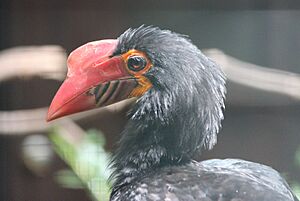Mindanao hornbill facts for kids
Quick facts for kids Mindanao hornbill |
|
|---|---|
 |
|
| Conservation status | |
| Scientific classification | |
| Genus: |
Penelopides
|
| Species: |
affinis
|
| Synonyms | |
|
Penelopides panini affinis |
|
The Mindanao hornbill (Penelopides affinis) is a cool bird that lives in the rainforests of the southern Philippines. You can find these medium-sized birds flying high in the treetops. They live on islands like Mindanao, Dinagat, Siargao, and Basilan.
Sometimes, people call this bird the Mindanao tarictic hornbill. It's part of a group of birds called tarictic hornbills.
Contents
What Are Subspecies?
Just like how different dog breeds are all still dogs, subspecies are slightly different groups within the same animal species. They often live in different places.
There are two main types, or subspecies, of the Mindanao hornbill:
- P. a. affinis: This group lives on the islands of Mindanao, Dinagat, and Siargao.
- P. affinis basilanica: This group lives on the island of Basilan.
How Do Mindanao Hornbills Behave?
Mindanao hornbills are very social birds. You'll often see them in pairs or small groups flying through the forest.
They are also quite noisy! They make a loud, repeating call that sounds like "ta-rik-tik." This is why they are sometimes called "tarictic" hornbills. Even though they are noisy, it can be hard to spot them. Their feathers help them blend in with the thick leaves of the rainforest.
What Do Mindanao Hornbills Eat?
The main food for the Mindanao hornbill is fruit. They love to eat different kinds of fruit they find in the forest canopy.
Besides fruit, they also eat small animals. This includes insects, beetles, ants, and sometimes even earthworms.
Mindanao Hornbills in Zoos
It's not very common to see Mindanao hornbills in zoos outside of the Philippines. Sometimes, when you do see them, they might be labeled with a slightly different name. This is because scientists have changed how they classify these birds over time.
For example, London Zoo used to have one of these birds. Today, only a few zoos, like the Hong Kong Zoological and Botanical Gardens, have them.



